Communicative Language Teaching (CLT),交际教学法,
- 格式:doc
- 大小:29.50 KB
- 文档页数:1
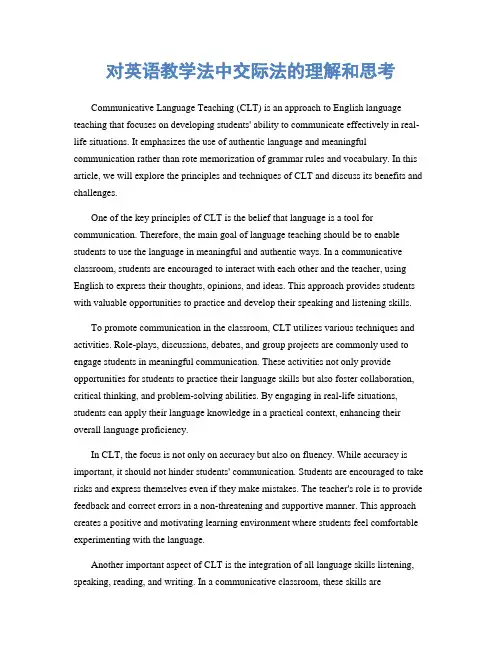
对英语教学法中交际法的理解和思考Communicative Language Teaching (CLT) is an approach to English language teaching that focuses on developing students' ability to communicate effectively in real-life situations. It emphasizes the use of authentic language and meaningful communication rather than rote memorization of grammar rules and vocabulary. In this article, we will explore the principles and techniques of CLT and discuss its benefits and challenges.One of the key principles of CLT is the belief that language is a tool for communication. Therefore, the main goal of language teaching should be to enable students to use the language in meaningful and authentic ways. In a communicative classroom, students are encouraged to interact with each other and the teacher, using English to express their thoughts, opinions, and ideas. This approach provides students with valuable opportunities to practice and develop their speaking and listening skills.To promote communication in the classroom, CLT utilizes various techniques and activities. Role-plays, discussions, debates, and group projects are commonly used to engage students in meaningful communication. These activities not only provide opportunities for students to practice their language skills but also foster collaboration, critical thinking, and problem-solving abilities. By engaging in real-life situations, students can apply their language knowledge in a practical context, enhancing their overall language proficiency.In CLT, the focus is not only on accuracy but also on fluency. While accuracy is important, it should not hinder students' communication. Students are encouraged to take risks and express themselves even if they make mistakes. The teacher's role is to provide feedback and correct errors in a non-threatening and supportive manner. This approach creates a positive and motivating learning environment where students feel comfortable experimenting with the language.Another important aspect of CLT is the integration of all language skills listening, speaking, reading, and writing. In a communicative classroom, these skills areinterconnected and taught in an integrated manner. For example, a reading activity can be followed by a discussion or a writing task, allowing students to practice and reinforce their language skills in a meaningful context. This integrated approach helps students develop a holistic understanding of the language and its use.CLT also emphasizes the use of authentic materials and real-life situations. Instead of relying solely on textbooks, teachers incorporate real-world resources such as newspapers, magazines, videos, and online content into their lessons. This exposes students to authentic language use and cultural aspects of the target language, making their learning experience more relevant and engaging.While CLT has many benefits, it also presents some challenges. One of the main challenges is the need for a supportive learning environment and adequate resources. CLT requires teachers to create interactive and communicative activities, which can be time-consuming to plan and implement. Additionally, classrooms need to be equipped with appropriate materials and technology to facilitate communication.Another challenge is the assessment of students' progress. Traditional assessment methods such as grammar tests may not accurately reflect students' communicative abilities. Therefore, alternative assessment methods such as oral presentations, group projects, and portfolios are often used to evaluate students' language proficiency in a communicative classroom.In conclusion, Communicative Language Teaching is an effective approach to English language teaching that focuses on developing students' ability to communicate in real-life situations. By providing opportunities for meaningful communication, integrating language skills, and using authentic materials, CLT enhances students' language proficiency and fosters their overall language development. While it presents challenges, the benefits of CLT in promoting effective communication outweigh the difficulties. As educators, embracing CLT can greatly benefit our students' language learning journey.。

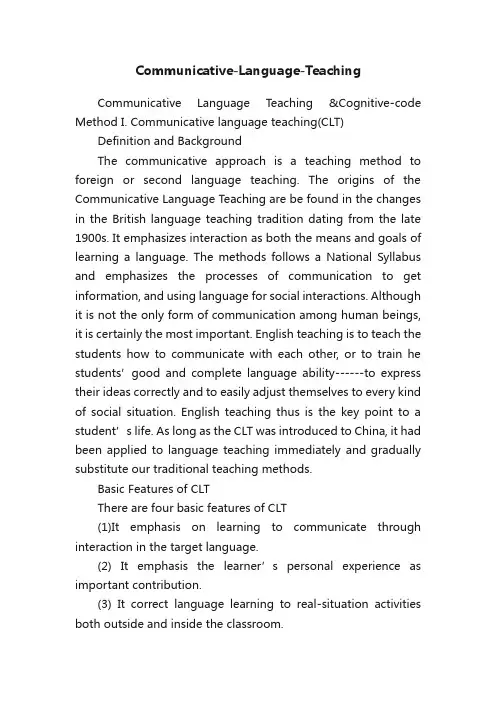
Communicative-Language-TeachingCommunicative Language T eaching &Cognitive-code Method I. Communicative language teaching(CLT)Definition and BackgroundThe communicative approach is a teaching method to foreign or second language teaching. The origins of the Communicative Language Teaching are be found in the changes in the British language teaching tradition dating from the late 1900s. It emphasizes interaction as both the means and goals of learning a language. The methods follows a National Syllabus and emphasizes the processes of communication to get information, and using language for social interactions. Although it is not the only form of communication among human beings, it is certainly the most important. English teaching is to teach the students how to communicate with each other, or to train he students’good and complete language ability------to express their ideas correctly and to easily adjust themselves to every kind of social situation. English teaching thus is the key point to a student’s life. As long as the CLT was introduced to China, it had been applied to language teaching immediately and gradually substitute our traditional teaching methods.Basic Features of CLTThere are four basic features of CLT(1)It emphasis on learning to communicate through interaction in the target language.(2) It emphasis the learner’s personal experience as important contribution.(3) It correct language learning to real-situation activities both outside and inside the classroom.(4) It is learner-centered and emphasis the learning precess itself.These four features clearly claimed that the CLT are very interested in the need and the desire as well as the communication of learners.|Teache r and Students’ RolesIn the CLT, the teacher serves as more of a facilitator, allowing students to be in the charge of their own learning process. They served as a organizer, adviser, facilitator and participant. As for the students, in CLT, students are asked to practice real-life situations. In these exercises, the goal is that the students need to communicate his or her needs and thoughts without caring about the correct grammar and sentence pattern. So everyone ca take part in the practice actively. In stead of the listeners, students are the manager, master and participant of their own study.Classroom ActivitiesNumerous of materials and aids can be used to support the communicative language teaching. Here is the criteria for CLT.(1)communicative purpose(2)Communicative desires(3)Focus on content, not the from(4)Variety of language(5)No teacher intervention(6)No material controlActivities examples: role play. Tell personal experienceand information exchange, picture stirp story, etc..>In the classroom of CLT often takes the form of paris ansgroup and it require the negotiation and cooperationbetweenlearners. activities can encourage and develop the competenceand skills.Evaluation of CLTCommunicative language teaching focus on thestudents-centered teaching practice. It simulates studentscuriosity and interest in learning and they can have good opportunities to have practice in learning. It ensures the results of learning process. One of the obvious benefit of this method is that the students are more responsible of their ownlearning than in a traditional teacher-centered classroom. Thus the relation ship between teachers and the students is interactive and harmonious. However, it still nee improving. Students’need of language input and p ractice needs the teacher to balance. As a results, this method need more skill than other approaches.Cognitive-code MethodDefinition and BackgroundThe cognitive-code method is an approach to foreign language teaching which is based on the belief that language learning is a process which involves active method processes and not simply the forming of habits. It lays emphasis on the conscious acquisition of language as a meaningful system. In the 1960s, the pedagogy, psychology and linguistics hand enjoyed their great development in American. As a result, the cognitive-code method comes into being. And the new approach absorbed beneficial theories for itself from those developed schools. This method is different from the CLT because it focus much more onthe mental process of studentsMain FeaturesThere are sis main features of the cognitive-code method (1)students-centered, teacher guides and stimulate studentsto learn;(2)It focus on students’ ability of language competence;(3)Against audio-lingual comes first,gives equal important in the four skills;(4)((5)Widely use teaching aids and materials to help in teaching;(6)Emphasis understand rather than recite;(7)Teacher can use their mother language to explain if necessary.This method emphasis the mental process of the students, and deal with the study of natures and learning of systems of knowledge. Students should have their own understand and ideas and be allowed to creat their own sentence.Role of Teacher and StudentsTeacher is the facilitator and guide of classroom. They stimulate students’ motivation and interest of learning, and guide them to find new things or rules from practice and new materials. Then offer them opportunities, materials, situations to do exercise. While students are the main part of classroom, they need to learn spontaneously and understand by heart.Classroom ActivitiesClassroom activities must focus on students feels andopinions. Also they can design activities they like. The aim of these activities is to let student learner new things from real-doing. Activities examples: learner primary practice, retell text use your own words, describing pictures, making sentences etc..EvaluationThe theory attaches more important to the learner’s understanding of the structure of the foreign language than to the facility in using the structure or the grammar. It is believed that it provide the students a proper degree of control and it will automatically help the students use the language in meaningful situation. However. It is difficult to select and prepare materials. In addition, because it is focus on the personal understanding , experience and analysis, thus it is suitable for adult language learners.。


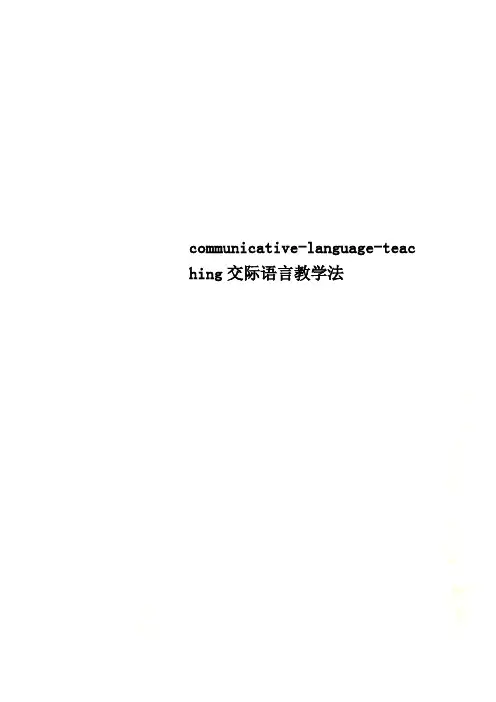
communicative-language-teac hing交际语言教学法Communicative language teachingFrom Wikipedia, the free encyclopediaCommunicative language teaching (CLT), or the communicative approach, isan approach to language teaching that emphasizes interaction as both the means and the ultimate goal of study. Language learners in environments utilizing CLT techniques learn and practice the target language through interaction with one another and the instructor, study of "authentic texts" (those written in the target language for purposes other than language learning), and use of the language in class combined with use of the language outside of class. Learners converse about personal experiences with partners, and instructors teach topics outside of the realm of traditional grammar in order to promote language skills in all types of situations. This method also claims to encourage learners to incorporate their personalexperiences into their language learning environment and focus on the learning experience in addition to the learning of the target language.[1] According to CLT, the goal of language education is the ability to communicate in the target language.[2] This is in contrast to previous views inwhich grammatical competence was commonly given top priority.[3] CLT also focuses on the teacher being a facilitator, rather than an instructor. Furthermore, the approach is a non-methodical system that does not use a textbook series to teach English but rather works on developing sound oral/verbal skills prior to reading and writing.Contents[hide]•1Backgroundo 1.1Societal influenceso 1.2Academic influences•2Classroom activitieso 2.1Role-playo 2.2Interviewso 2.3Group worko 2.4Information gapfunctions are expressed through grammar, and Dell Hymes, who introduced the idea of a wider communicative competence instead of Chomsky's narrower linguistic competence.[4] The rise of CLT in the 1970s and early 1980s was partly in response to the lack of success with traditional language teaching methods and partly due to the increase in demand for language learning. In Europe, the advent ofthe European Common Market, an economic predecessor to the European Union, led to migration in Europe and an increased population of people who needed to learn a foreign language for work or for personal reasons. At the same time, more children were given the opportunity to learn foreign languages in school, as the number of secondary schools offering languages rose worldwide as part of a general trend of curriculum-broadening and modernization, and foreign-language study ceased to beconfined to the elite academies. In Britain, the introduction of comprehensive schools, which offered foreign-language study to all children rather than to the select few in the elite grammar schools, greatly increased the demand for language learning.[5]This increased demand included many learners who struggled with traditional methods such as grammar translation, which involves the direct translation of sentence after sentence as a way to learn language. These methods assumed that students were aiming for mastery of the target language, and that students were willing to study for years before expecting to use the language in real life. However, these assumptions were challenged by adult learners, who were busy with work, and some schoolchildren, who were less academically gifted, and thus could not devote years to learning before being able to use the language. Educators realizedthat to motivate these students an approach with a more immediate payoff was necessary,[6] and they began to use CLT, an approach that emphasizes communicative ability and yielded better results.[7]Additionally, the trend of progressivism in education provided further pressure for educators to change their methods. Progressivism holds that active learning is more effective than passive learning,[6] and as this idea gained traction in schools there was a general shift towards using techniques where students were more actively involved, such as group work. Foreign-language education was no exception to this trend, and teachers sought to find new methods, such as CLT, that could better embody this shift in thinking.[6]Academic influences[edit]The development of communicative language teaching was bolstered by new academic ideas. Before the growth of communicative language teaching, the primary method of language teaching was situational language teaching. This method was much more clinical in nature and relied less on direct communication. In Britain, applied linguists began to doubt the efficacy of situational language teaching. This was partly in response to Chomsky's insights into the nature of language. Chomsky had shown that the structural theories of language prevalent at the time could not explain the variety found in real communication.[8] In addition, applied linguists such as Christopher Candlinand Henry Widdowson observed that the current model of language learning was ineffective in classrooms. They saw a need for students to develop communicative skilland functional competence in addition to mastering language structures.[8]In 1966, linguist and anthropologist Dell Hymes developed the conceptof communicative competence. Communicative competence redefined what it meant to "know" a language; in addition to speakers having mastery over the structural elements of language, they must also be able to use those structural elements appropriately in a variety of speech domains.[2] This can be neatly summed up by Hymes's statement, "There are rules of use without which the rules of grammar would be useless."[5] The idea of communicative competence stemmed from Chomsky's concept of the linguistic competence of an ideal nativespeaker.[2] Hymes did not make a concrete formulation of communicative competence, but subsequent authors have tied the concept to language teaching, notablyMichael Canale.[9] Canale and Swain (1980) defined communicative competence in terms of three components: grammatical competence, sociolinguistic competence, and strategic competence. Canale (1983) refined the model by adding discourse competence, which contains the concepts of cohesion and coherence.[9]An influential development in the history of communicative language teaching was the work of the Council of Europe in creating new language syllabi. When communicative language teaching had effectively replaced situational language teaching as the standard by leading linguists, the Council of Europe made an effort to once again bolster the growth of the new method. This led to the Council of Europe creating a new language syllabus. Education was a highpriority for the Council of Europe, and they set out to provide a syllabus that would meet the needs of European immigrants.[8] Among the studies used by the council when designing the course was one by the British linguist, D. A. Wilkins, that defined language using "notions" and "functions", rather than more traditional categories of grammar and vocabulary. The new syllabus reinforced the idea that language could not be adequately explained by grammar and syntax, and instead relied on real interaction.[8]In the mid 1990s, the Dogme 95 manifesto influenced language teaching throughthe Dogme language teaching movement. This proposed that published materials stifle the communicative approach. As such, the aim of the Dogme approach to languageteaching is to focus on real conversations about practical subjects, where communication is the engine of learning. The idea behind the Dogme approach is that communication can lead to explanation, which will lead to further learning. This approach is the antithesis of situational language teaching, which emphasizes learning through text and prioritizes grammar over communication.[10]A survey of communicative competence by Bachman (1990) divides competency into the broad headings of "organizational competence", which includes both grammatical and discourse (or textual) competence, and "pragmatic competence", which includes both sociolinguistic and "illocutionary" competence.[11] Strategic competence is associated with the interlocutors' ability in using communication strategies.[11]Classroom activities[edit]CLT teachers choose classroom activities based on what they believe is going to be most effective for students developing communicative abilities in the target language (TL). Oral activities are popular among CLT teachers, as opposed to grammar drills or reading and writing activities, because they include active conversation and creative, unpredicted responses from students. Activities vary based on the level of language class they are being used in. They promote collaboration, fluency, and comfort in the TL. The six activities listed and explained below are commonly used in CLT classrooms.[6]Role-play[edit]Role-play is an oral activity usually done in pairs, whose main goal is to develop students' communicative abilities in a certain setting.[5]Example:1. T he instructor sets the scene: where isthe conversation taking place? (E.g., ina café, in a park, etc.)2. T he instructor defines the goal of thestudents' conversation. (E.g., thespeaker is asking for directions, thespeaker is ordering coffee, the speaker is talking about a movie they recentlysaw, etc.)3. T he students converse in pairs for adesignated amount of time.This activity gives students the chance to improve their communication skills in the TL in a low-pressure situation. Most students are more comfortable speaking in pairs rather than in front of the entire class.[5]Instructors need to be aware of the differences between a conversation and an utterance. Students may use the sameutterances repeatedly when doing this activity and not actually have a creative conversation. If instructors do not regulate what kinds of conversations students are having, then the students might not be truly improving their communication skills.[5] Interviews[edit]An interview is an oral activity done in pairs, whose main goal is to develop students' interpersonal skills in the TL.[12]Example:1. T he instructor gives each student thesame set of questions to ask a partner.2. S tudents take turns asking andanswering the questions in pairs.This activity, since it is highly-structured, allows for the instructor to more closely monitor students' responses. It can zone in on one specific aspect of grammar or vocabulary, while still being a primarilycommunicative activity and giving the students communicative benefits.[12]This is an activity that should be used primarily in the lower levels of language classes, because it will be most beneficial to lower-level speakers. Higher-level speakers should be having unpredictable conversations in the TL, where neither the questions nor the answers are scripted or expected. If this activity were used with higher-level speakers it wouldn't have many benefits.[12]Group work[edit]Group work is a collaborative activity whose purpose is to foster communication in the TL, in a larger group setting.[13] Example:1. S tudents are assigned a group of nomore than six people.2. S tudents are assigned a specific rolewithin the group. (E.g., member A,member B, etc.)3. T he instructor gives each group thesame task to complete.4. E ach member of the group takes adesignated amount of time to work onthe part of the task to which they areassigned.5. T he members of the group discuss theinformation they have found, with eachother and put it all together to complete the task.Students can feel overwhelmed in language classes, but this activity can take away from that feeling. Students are asked to focus on one piece of information only, which increases their comprehension of that information. Better comprehension leads to better communication with the rest of the group, which improves students' communicative abilities in the TL.[13]Instructors should to be sure to monitor that each student is contributing equally to the group effort. It takes a good instructor to design the activity well, so that students will contribute equally, and benefit equally from the activity.[13]Information gap[edit]Information gap is a collaborative activity, whose purpose is for students to effectively obtain information that was previously unknown to them, in the TL.[14]Example:1. T he class is paired up. One partner ineach pair is Partner A, and the other isPartner B.2. A ll the students that are Partner A aregiven a sheet of paper with a time-table on it. The time-table is filled in half-way, but some of the boxes are empty.3. A ll the students that are Partner B aregiven a sheet of paper with a time-tableon it. The boxes that are empty onPartner A's time-table are filled in onPartner B's. There are also emptyboxes on Partner B's time-table, butthey are filled in on Partner A's.4. T he partners must work together to askabout and supply each other with theinformation they are both missing, tocomplete each other's time-tables. Completing information gap activities improves students' abilities to communicate about unknown information in the TL. These abilities are directly applicable to many real-world conversations, where the goal is to find out some new piece of information, or simply to exchange information.[14]Instructors should not overlook the fact that their students need to be prepared to communicate effectively for this activity. They need to know certain vocabulary words, certain structures of grammar, etc. Ifthe students have not been well prepared for the task at hand, then they will not communicate effectively.[15]Opinion sharing[edit]Opinion sharing is a content-based activity, whose purpose is to engage students' conversational skills, while talking about something they care about.[15]Example:1. T he instructor introduces a topic andasks students to contemplate theiropinions about it. (E.g., dating, schooldress codes, global warming)2. T he students talk in pairs or smallgroups, debating their opinions on thetopic.Opinion sharing is a great way to get more introverted students to open up and share their opinions. If a student has a strong opinion about a certain topic, then they will speak up and share.[15]Respect is key with this activity. If a student does not feel like their opinion is respected by the instructor or their peers, then they will not feel comfortable sharing, and they will not receive the communicative benefits of this activity.[15]Scavenger hunt[edit]A scavenger hunt is a mingling activity that promotes open interaction between students.[16]Example:1. T he instructor gives students a sheetwith instructions on it. (e.g. Findsomeone who has a birthday in thesame month as yours.)2. S tudents go around the classroomasking and answering questions abouteach other.3. T he students wish to find all of theanswers they need to complete thescavenger hunt.In doing this activity, students have the opportunity to speak with a number of classmates, while still being in alow-pressure situation, and talking to only one person at a time. After learning more about each other, and getting to share about themselves, students will feel more comfortable talking and sharing during other communicative activities.[16]Since this activity is not as structured as some of the others, it is important for instructors to add structure. If certain vocabulary should be used in students' conversations, or a certain grammar is necessary to complete the activity, then instructors should incorporate that into the scavenger hunt.[16]Critiques[edit]Although CLT has been extremely influential in the field of language teaching,it is not universally accepted and has been subject to significant critique.[17]In his critique of CLT, MichaelSwan addresses both the theoretical and practical problems with CLT. In his critique, he mentions that CLT is not an altogether cohesive subject, but one in which theoretical understandings (by linguists) and practical understandings (by language teachers) differ greatly. Critique of the theory of CLT includes that it makes broad claims regarding the usefulness of CLT while citing little data, that it uses a large amount of confusing vocabulary, and that it assumes knowledge that is predominately language non-specific (ex. the ability to make educated guesses) is language specific.[17] Swan suggests that these theoretical issues can lead to confusion in the application of CLT techniques.[18]Where confusion in the application of CLT techniques is readily apparent is inclassroom settings. Swan suggests that CLT techniques often suggest prioritizing the "function" of a language (what one can do with the language knowledge one has) over the "structure" of a language (the grammatical systems of thelanguage).[18] This priority can leave learners with serious gaps in their knowledge of the formal aspects of their target language. Swan also suggests that, in CLT techniques, whatever languages a student might already know are not valued or employed in instructional techniques.[18]Further critique of CLT techniques in classroom teaching can be attributed to Elaine Ridge. One of her critiques of CLT is that it implies that there is a generally agreed upon consensus regarding the definition of "communicative competence," which CLT claims to facilitate, when in fact there is not. Because there is not such agreement, students may be seen to be inpossession of "communicative competence" without being able to make full, or even adequate, use of the language. That an individual is proficient in a language does not necessarily entail that they can make full use of that language, which can limit an individual's potential with that language, especially if that language is an endangered language. This critique is largely to do with the fact that CLT is often highly praised and is popular, when it may not necessarily be the best method of language teaching.[19]Ridge also notes that CLT has nonspecific requirements of its teachers, as there is no completely standard definition of what CLT is; this is especially true for the teaching of grammar (the formal rules governing the standardized version of the language in question). Some critics of CLT suggest that the method does not put enough emphasis on the teaching of grammar and insteadallows students to produce utterances which are grammatically incorrect as long as the interlocutor can get some meaning from them.[19]Stephen Bax's critique of CLT has to do with the context of its implementation. Bax asserts that many researchers associate the use of CLT techinques with modernity and, therefore, the lack of CLT techniques as a lack of modernism. In this way, these researchers consider teachers or school systems which don't use CLT techniques as outdated and suggest that their students learn the target language "in spite of" the absence of CLT techniques, as though CLT were the only way to learn a language and everyone who fails to implement its techniques is ignorant and will not be successful in teaching the target language.[3]See also[edit]。
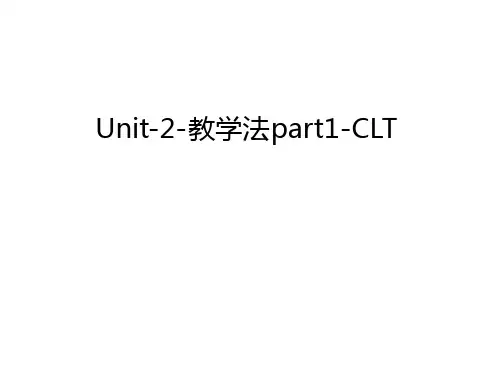
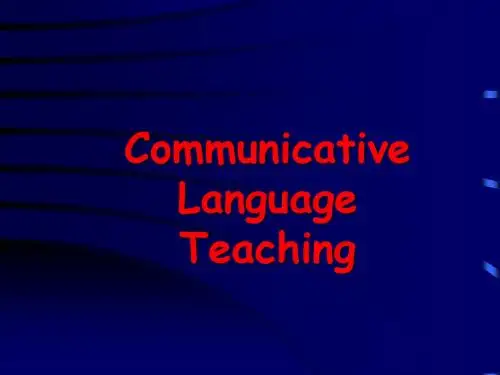
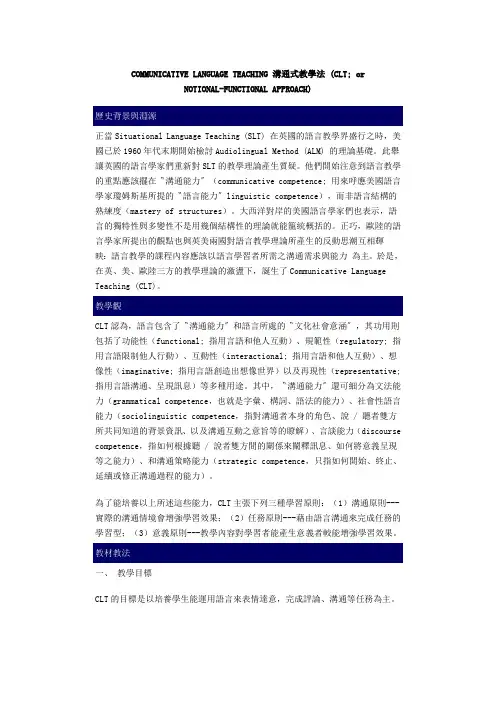
COMMUNICATIVE LANGUAGE TEACHING 溝通式教學法 (CLT; orNOTIONAL-FUNCTIONAL APPROACH)正當Situational Language Teaching (SLT) 在英國的語言教學界盛行之時,美國已於1960年代末期開始檢討Audiolingual Method (ALM) 的理論基礎。
此舉讓英國的語言學家們重新對SLT的教學理論產生質疑。
他們開始注意到語言教學的重點應該擺在〝溝通能力〞(communicative competence; 用來呼應美國語言學家瓊姆斯基所提的〝語言能力〞linguistic competence),而非語言結構的熟練度(mastery of structures)。
大西洋對岸的美國語言學家們也表示,語言的獨特性與多變性不是用幾個結構性的理論就能籠統概括的。
正巧,歐陸的語言學家所提出的觀點也與英美兩國對語言教學理論所產生的反動思潮互相輝映:語言教學的課程內容應該以語言學習者所需之溝通需求與能力為主。
於是,在英、美、歐陸三方的教學理論的激盪下,誕生了Communicative Language Teaching (CLT)。
CLT認為,語言包含了〝溝通能力〞和語言所處的〝文化社會意涵〞,其功用則包括了功能性(functional; 指用言語和他人互動)、規範性(regulatory; 指用言語限制他人行動)、互動性(interactional; 指用言語和他人互動)、想像性(imaginative; 指用言語創造出想像世界)以及再現性(representative; 指用言語溝通、呈現訊息)等多種用途。
其中,〝溝通能力〞還可細分為文法能力(grammatical competence,也就是字彙、構詞、語法的能力)、社會性語言能力(sociolinguistic competence,指對溝通者本身的角色、說 / 聽者雙方所共同知道的背景資訊、以及溝通互動之意旨等的瞭解)、言談能力(discourse competence,指如何根據聽 / 說者雙方間的關係來闡釋訊息、如何將意義呈現等之能力)、和溝通策略能力(strategic competence,只指如何開始、終止、延續或修正溝通過程的能力)。
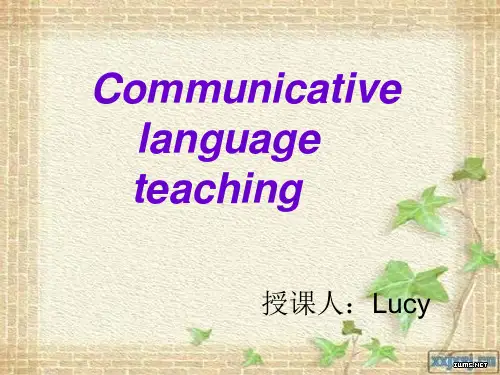
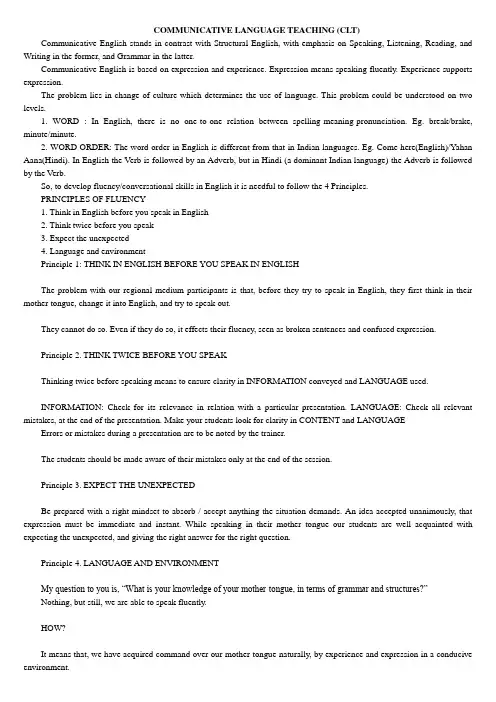
COMMUNICATIVE LANGUAGE TEACHING (CLT)Communicative English stands in contrast with Structural English, with emphasis on Speaking, Listening, Reading, and Writing in the former, and Grammar in the latter.Communicative English is based on expression and experience. Expression means speaking fluently. Experience supports expression.The problem lies in change of culture which determines the use of language. This problem could be understood on two levels.1. WORD : In English, there is no one-to-one relation between spelling-meaning-pronunciation. Eg. break/brake, minute/minute.2. WORD ORDER: The word order in English is different from that in Indian languages. Eg. Come here(English)/Yahan Aana(Hindi). In English the Verb is followed by an Adverb, but in Hindi (a dominant Indian language) the Adverb is followed by the Verb.So, to develop fluency/conversational skills in English it is needful to follow the 4 Principles.PRINCIPLES OF FLUENCY1. Think in English before you speak in English2. Think twice before you speak3. Expect the unexpected4. Language and environmentPrinciple 1: THINK IN ENGLISH BEFORE YOU SPEAK IN ENGLISHThe problem with our regional medium participants is that, before they try to speak in English, they first think in their mother tongue, change it into English, and try to speak out.They cannot do so. Even if they do so, it effects their fluency, seen as broken sentences and confused expression.Principle 2. THINK TWICE BEFORE YOU SPEAKThinking twice before speaking means to ensure clarity in INFORMA TION conveyed and LANGUAGE used.INFORMA TION: Check for its relevance in relation with a particular presentation. LANGUAGE: Check all relevant mistakes, at the end of the presentation. Make your students look for clarity in CONTENT and LANGUAGE Errors or mistakes during a presentation are to be noted by the trainer.The students should be made aware of their mistakes only at the end of the session.Principle 3. EXPECT THE UNEXPECTEDBe prepared with a right mindset to absorb / accept anything the situation demands. An idea accepted unanimously, that expression must be immediate and instant. While speaking in their mother tongue our students are well acquainted with expecting the unexpected, and giving the right answer for the right question.Principle 4. LANGUAGE AND ENVIRONMENTMy question to you is, “What is your knowledge of your mother-tongue, in terms of grammar and structures?”Nothing, but still, we are able to speak fluently.HOW?It means that, we have acquired command over our mother-tongue naturally, by experience and expression in a conducive environment.CONCLUSIONLanguage or expression is an art, and a treasured possession of the human race. The easiest way to master it, is by expression and experience, as we did with our mother-tongue.(You can contact me at risens@)Sanjay NannaparajuGuest#2 (permalink) Thu Aug 11, 2005 10:24 am Communicative Language TeachingI've been trained to teach Spanish both with a communicative method and a task-based method. I have to say that it would have been great to have been taught English that way. I remember being able to read some Virginia Wolf's texts, while I didn't know how to ask for something in a shop in English. Even now, my fluency is not as good as my grammar-level is.The problem is that I've used many English textbooks, and even though they claim to be communicative, they usually are estructural.I didn't understand the way you explained what a communicative method is, Sanjay. I was taught to give classes in Spanish another way. I'll try and explain it:You split the class in four parts:-Warm-up: the student's start practicing Spanish with a short game, about 5 minutes.-Language presentation:You teach the students the vocabulary, grammar and functions you want them to learn.-Controlled practice (there must be another name for it in English, I'm translating from the Spanish): the students practice the language they've been taught. Every mistake must be corrected at once. Only one answer is tolerated, the correct one. If they fail too many times, it's very likely that the exercise is not good, or that the teacher didn't explain the language correctly in the previous part.-Free practice: the student's are given another exercise, but this time they are encouraged to use not only the language they've been taught in this class, but all the words and expressions that they may need. Corrections must be made at the end of the class, and the teacher shouldn't correct anything apart from the language which has been taught in this class.Everything must be taught in a very motivated way. Actually, when I was trained to give classes this way, I sometimes felt that with this method the students are seen as a bunch of lazy people who must be treated very sweatly. It sometimes was too much.I wrote about the functions, and some people may don't know what they are. Let's give an example: an English friend of mine told me once that I was the most polite Spaniard he'd ever met. But he told me that in English I sometimes was rude: "Why?", I asked him. And he told me that I used to ask for things using the imperative. That's how we do it in Spanish, and as long as you say "please" at the end, there's no problem in most situations. But he told me that in English the imperative was much less used than in Spanish. He taught me to say: "could you please...?" And then more expressions which can sometimes be too polite: "I was wondering if you..., excuse me, I wonder if you could..., would you mind...?"What I mean is that with grammar you learn to join a word with the next, and that way you're assured to form sentences that are grammatically correct. But they may sound strange, or they may even be unpolite, as it was my case.I'm sure that the most structural method take these things into account, but they don't give them the importance they have.CarbonariusI'm new here and I like it ;-)Joined: 28 Mar 2005Posts: 44Location: Basque Country, SpainIn this story you'll learn how to use the English articles English grammar exercises — improve your English knowledge and vocabulary skills Are you a native speaker of English? Then you should read this! Here is how you can learn English the fun way! Click to subscribe to free email English course#3 (permalink) Fri Aug 12, 2005 1:32 am Think twice before you speakHello,What is happening?How can a person think twice before speaking?Will people wait for one to compse his essay and later devour his words? Is everyone a Caesar, for people to wait for him to open his mouth.How long will the audience wait?Has the person extending this advice ever tried to put 'thinking twice before speaking ' into test by adopting it himself- either when speaking to his friends or in the classroom or on a platform? This may provide the strange sight of a man standing, looking at you intently whithout saying anything or replying, or one opening and closing his mouth like a fish because he had not completed thinking and has not come to a conclusion on what words to use and is not ready to add sound to his words.Expect for the first, all others are useless. These may sound good in a useless term paper or theses.Even the first, if meant to develop 'double-think' should be avoided like plague.Let him who propounds, first try these and then suggest them to others.They are impractical, class room gimmickes used to attract non-native speakers as learners, who are, at present, worth their weight in gold.All other branches of knowledge seem to have something to teach. But when you start teaching any language, you find most of the learners disinterested. So such high sounding sentences are used to create an awe amoung mature learners.Fluent speech, in any language, is possble only when it is done without thinking. Seems stange?When I say without thinking, I mean a sort of automatic reply which is normal whatever language you speak. A reply in a language to a question asked in that language.Except this and such others like speaking to friends, gossiping and discussing things with the boss and others in one's office, all others can only be strained expressions.。
c o m m u n i c a t i v e l a n g ue t e a c h i n g交际语言教学法Revised final draft November 26, 2020C o m m u n i c a t i v e l a n g u a g e t e a c h i n g From Wikipedia, the free encyclopediaCommunicative language teaching(CLT), or the communicative approach, is antothat emphasizesas both the means and the ultimate goal of study. Language learners in environments utilizing CLT techniques learn and practice the target language through interaction with one another and the instructor, study of "authentic texts" (those written in the target language for purposes other than language learning), and use of the language in class combined with use of the language outside of class. Learners converse about personal experiences with partners, and instructors teach topics outside of the realm of traditional grammar in order to promote language skills in all types of situations. This method also claims to encourage learners to incorporate their personal experiences into their language learning environment and focus on the learning experience in addition to the learning of the target language.According to CLT, the goal of language education is the ability to communicate in the target language.This is in contrast to previous views in whichwas commonly given top priority.CLT also focuses on the teacher being a facilitator, rather than an instructor. Furthermore, the approach is a non-methodical system that does not use a textbook series to teach English but rather works on developing sound oral/verbal skills prior to reading and writing.Contents[hide]ooooooooBackground[]Societal influences[]Language teaching was originally considered a cognitive matter, mainly involving memorization. It was later thought, instead, to be socio-cognitive, meaning that language can be learned through the process of social interaction. Today, however, the dominant technique in teaching any language is communicative language teaching (CLT).It was's theories in the 1960s, focusing on competence and performance in language learning, that gave rise to communicative language teaching, but the conceptual basis for CLT was laid in the 1970s by linguists Michael Halliday, who studied how language functions are expressed through grammar, and Dell Hymes, who introduced the idea of a wider communicative competence instead of Chomsky's narrower linguistic competence.The rise of CLT in the 1970s and early 1980s was partly in response to the lack of success with traditional language teaching methods and partly due to the increase in demand for language learning. In Europe, the advent of the, an economic predecessor to the European Union, led to migration in Europe and an increased population of people who needed to learn a foreign language for work or for personal reasons. At the same time, more children were given the opportunity to learn foreign languagesin school, as the number of secondary schools offering languages rose worldwide as part of a general trend of curriculum-broadening and modernization, and foreign-language study ceased to be confined to the elite academies. In Britain, the introduction of, which offered foreign-language study to all children rather than to the select few in the elite, greatly increased the demand for language learning.This increased demand included many learners who struggled with traditional methods such as, which involves the direct translation of sentence after sentence as a way to learn language. These methods assumed that students were aiming for mastery of the target language, and that students were willing to study for years before expecting to use the language in real life. However, these assumptions were challenged by adult learners, who were busy with work, and some schoolchildren, who were less academically gifted, and thus could notdevote years to learning before being able to use the language. Educators realized that to motivate these students an approach with a more immediate payoff was necessary,and they began to use CLT, an approach that emphasizes communicative ability and yielded better results.Additionally, the trend ofin education provided further pressure for educators to change their methods. Progressivism holds that active learning is more effective than passive learning,and as this idea gained traction in schools there was a general shift towards using techniques where students were more actively involved, such as group work. Foreign-language education was no exception to this trend, and teachers sought to find new methods, such as CLT, that could better embody this shift in thinking.Academic influences[]The development of communicative language teaching was bolstered by new academic ideas. Before the growth of communicative language teaching, the primary method of language teaching was situational language teaching. This method was much more clinical in nature and relied less on direct communication. In Britain, applied linguists began to doubt the efficacy of situational language teaching. Thiswas partly in response to Chomsky's insights into the nature of language. Chomsky had shown that the structural theories of language prevalent at the time could not explain the variety found in real communication.In addition, applied linguists such as Christopher Candlin andobserved that the current model of language learning was ineffective in classrooms. They saw a need for students to develop communicative skill and functional competence in addition tomastering language structures.In 1966, linguist and anthropologistdeveloped the concept of. Communicative competence redefined what it meant to "know" a language; in addition to speakers having mastery over the structural elementsof language, they must also be able to use those structural elements appropriately in a variety of speech domains.This can be neatly summed up by Hymes's statement, "There are rules of use without which the rules of grammar would be useless."The idea of communicative competence stemmed from Chomsky's concept of theof an ideal native speaker.Hymes did not make a concrete formulation of communicative competence, but subsequent authors have tied the concept to language teaching, notably Michael Canale.Canale and Swain (1980) definedcommunicative competence in terms of three components: grammatical competence,competence, and strategic competence. Canale (1983)refined the model by adding discourse competence, which contains the concepts ofand.In the mid 1990s, the Dogme 95 manifesto influenced language teaching through themovement. This proposed that published materials stiflethe communicative approach. As such, the aim of the Dogme approach to language teaching is to focus on real conversations about practical subjects, where communication is the engine of learning. The idea behind the Dogme approach is that communication can lead to explanation, which will lead to further learning. This approach isthe antithesis of situational language teaching, which emphasizes learning through text and prioritizes grammar over communication.A survey of communicative competence by Bachman (1990) divides competency into the broad headings of "organizational competence", which includes both grammatical and discourse (or textual) competence, and "pragmatic competence", which includes both sociolinguistic and "" competence.Strategic competence is associated with theinterlocutors' ability in using communication strategies.CLT teachers choose classroom activities based on what they believeis going to be most effective for students developing communicative abilities in the target language (TL). Oral activities are popularamong CLT teachers, as opposed to grammar drills or reading and writing activities, because they include active conversation and creative, unpredicted responses from students. Activities vary based on the level of language class they are being used in. They promote collaboration, fluency, and comfort in the TL. The six activities listed and explained below are commonly used in CLT classrooms.Role-play[]Role-play is an oral activity usually done in pairs, whose main goal is to develop students' communicative abilities in a certain setting.Example:1.The instructor sets the scene: where is the conversation takingplace (E.g., in a café, in a park, etc.)2.The instructor defines the goal of the students' conversation.(E.g., the speaker is asking for directions, the speaker isordering coffee, the speaker is talking about a movie theyrecently saw, etc.)3.The students converse in pairs for a designated amount of time.This activity gives students the chance to improve their communication skills in the TL in a low-pressure situation. Most students are more comfortable speaking in pairs rather than in front of the entire class.Instructors need to be aware of the differences between a conversation and an utterance. Students may use the same utterances repeatedly when doing this activity and not actually have a creative conversation. If instructors do not regulate what kinds of conversations students are having, then the students might not be truly improving their communication skills.Interviews[]An interview is an oral activity done in pairs, whose main goal is to develop students' interpersonal skills in the TL.Example:1.The instructor gives each student the same set of questions toask a partner.2.Students take turns asking and answering the questions in pairs.This activity, since it is highly-structured, allows for theinstructor to more closely monitor students' responses. It can zonein on one specific aspect of grammar or vocabulary, while still being a primarily communicative activity and giving the students communicative benefits.This is an activity that should be used primarily in the lower levels of language classes, because it will be most beneficial to lower-level speakers. Higher-level speakers should be having unpredictable conversations in the TL, where neither the questions nor the answers are scripted or expected. If this activity were used with higher-level speakers it wouldn't have many benefits.Group work[]Group work is a collaborative activity whose purpose is to foster communication in the TL, in a larger group setting.Example:1.Students are assigned a group of no more than six people.2.Students are assigned a specific role within the group. (E.g.,member A, member B, etc.)3.The instructor gives each group the same task to complete.4.Each member of the group takes a designated amount of time towork on the part of the task to which they are assigned.5.The members of the group discuss the information they havefound, with each other and put it all together to complete thetask.Students can feel overwhelmed in language classes, but this activity can take away from that feeling. Students are asked to focus on one piece of information only, which increases their comprehension ofthat information. Better comprehension leads to better communication with the rest of the group, which improves students' communicative abilities in the TL.Instructors should to be sure to monitor that each student is contributing equally to the group effort. It takes a good instructorto design the activity well, so that students will contribute equally, and benefit equally from the activity.Information gap[]is a collaborative activity, whose purpose is for students to effectively obtain information that was previously unknown to them,in the TL.Example:1.The class is paired up. One partner in each pair is Partner A,and the other is Partner B.2.All the students that are Partner A are given a sheet of paperwith a time-table on it. The time-table is filled in half-way, but some of the boxes are empty.3.All the students that are Partner B are given a sheet of paperwith a time-table on it. The boxes that are empty on PartnerA's time-table are filled in on Partner B's. There are alsoempty boxes on Partner B's time-table, but they are filled inon Partner A's.4.The partners must work together to ask about and supply eachother with the information they are both missing, to completeeach other's time-tables.Completing information gap activities improves students' abilities to communicate about unknown information in the TL. These abilities are directly applicable to many real-world conversations, where the goal is to find out some new piece of information, or simply to exchange information.Instructors should not overlook the fact that their students need to be prepared to communicate effectively for this activity. They need to know certain vocabulary words, certain structures of grammar, etc. If the students have not been well prepared for the task at hand, then they will not communicate effectively.Opinion sharing[]Opinion sharing is a content-based activity, whose purpose is to engage students' conversational skills, while talking about something they care about.Example:1.The instructor introduces a topic and asks students tocontemplate their opinions about it. (E.g., dating, schooldress codes, global warming)2.The students talk in pairs or small groups, debating theiropinions on the topic.Opinion sharing is a great way to get more introverted students to open up and share their opinions. If a student has a strong opinion about a certain topic, then they will speak up and share.Respect is key with this activity. If a student does not feel like their opinion is respected by the instructor or their peers, then they will not feel comfortable sharing, and they will not receive the communicative benefits of this activity.Scavenger hunt[]A scavenger hunt is a mingling activity that promotes openinteraction between students.Example:1.The instructor gives students a sheet with instructions on it.(e.g. Find someone who has a birthday in the same month asyours.)2.Students go around the classroom asking and answering questionsabout each other.3.The students wish to find all of the answers they need tocomplete the scavenger hunt.In doing this activity, students have the opportunity to speak with a number of classmates, while still being in a low-pressure situation, and talking to only one person at a time. After learning more about each other, and getting to share about themselves, students will feel more comfortable talking and sharing during other communicative activities.Since this activity is not as structured as some of the others, it is important for instructors to add structure. If certain vocabulary should be used in students' conversations, or a certain grammar is necessary to complete the activity, then instructors should incorporate that into the scavenger hunt.Although CLT has been extremely influential in the field of language teaching, it is not universally accepted and has been subject to significant critique.In his critique of CLT,addresses both the theoretical and practical problems with CLT. In his critique, he mentions that CLT is not an altogether cohesive subject, but one in which theoretical understandings (by linguists) and practical understandings (by language teachers) differ greatly. Critique of the theory of CLT includes that it makes broad claims regarding the usefulness of CLT while citing little data, that it uses a large amount of confusing vocabulary, and that it assumes knowledge that is predominately language non-specific (ex. the ability to make educated guesses) is language specific.Swan suggests that these theoretical issues canlead to confusion in the application of CLT techniques.Where confusion in the application of CLT techniques is readily apparent is in classroom settings. Swan suggests that CLT techniques often suggest prioritizing the "function" of a language (what one can do with the language knowledge one has) over the "structure" of a language (the grammatical systems of the language).This priority can leave learners with serious gaps in their knowledge of the formal aspects of their target language. Swan also suggests that, in CLT techniques, whatever languages a student might already know are not valued or employed in instructional techniques.Further critique of CLT techniques in classroom teaching can be attributed to Elaine Ridge. One of her critiques of CLT is that it implies that there is a generally agreed upon consensus regarding the definition of "communicative competence," which CLT claims to facilitate, when in fact there is not. Because there is not such agreement, students may be seen to be in possession of "communicative competence" without being able to make full, or even adequate, use of the language. That an individual is proficient in a language does not necessarily entail that they can make full use of that language,which can limit an individual's potential with that language, especially if that language is an endangered language. This critiqueis largely to do with the fact that CLT is often highly praised andis popular, when it may not necessarily be the best method of language teaching.Ridge also notes that CLT has nonspecific requirements of its teachers, as there is no completely standard definition of what CLT is; this is especially true for the teaching of grammar (the formal rules governing the standardized version of the language in question). Some critics of CLT suggest that the method does not put enough emphasis on the teaching of grammar and instead allows students toproduce utterances which are grammatically incorrect as long as the interlocutor can get some meaning from them.Stephen Bax's critique of CLT has to do with the context of its implementation. Bax asserts that many researchers associate the use of CLT techinques with modernity and, therefore, the lack of CLT techniques as a lack of modernism. In this way, these researchers consider teachers or school systems which don't use CLT techniques as outdated and suggest that their students learn the target language "in spite of" the absence of CLT techniques, as though CLT were the only way to learn a language and everyone who fails to implement its techniques is ignorant and will not be successful in teaching the target language.。
近十年来,我国中学外语教学的重要议题之一是交际语言教学的原则研究与教学中的应用。
交际语言教学(Communicative Language Teaching,即CLT)形成与70年代末、80年代初。
经过近20年的发展以逐渐发展成为一种为世界语言教学界所普遍认同的教学思想、教学方向。
它的理论主要来自社会语言学、心理语言学和乔姆斯基的转换生成法。
其核心是教语言应当教学生怎样使用语言,用语言达到交际的目的,而不是把教会学生一套语法规则和零碎的词语用法作为语言教学的最终目标。
我国的英语教学新大纲和新教材都充分体现了交际语言教学思想。
《全日制高级中学英语教学大纲》在教学目的中明确规定:“在义务教育初中英语教学的基础上,巩固、扩大学生的基础知识,发展听、说、读、写的基本技能,培养在口头上和书面上初步运用英语交际的能力,侧重培养学生能力,并使学生获得一定的自学能力,为继续学习和运用英语切实打好基础。
“为达到这一目标的要求,“在英语教学中要努力使基础知识转化为语言技能,并发展成运用英语进行交际的能力。
”英语新教材的启用充分体现了以语言使用作为教学目标,在交际的语言环境中进行英语教学,通过大量语言实践把知识转化为语言技能并使这项技能发展为语言交际能力的精神。
因此在中学英语教学中运用交际语言教学法是大势所趋,也是一条必经之路,而多媒体辅助教学则为交际语言教学打开了一个新的局面。
多媒体教学是指在教学过程中,根据教学目标和教学对象的特点,通过教学设计,合理选择和运用现代教学媒体,并与传统教学手段相结合,共同参与教学全过程,以多种媒体信息作用于学生,形成合理的教学过程结构,达到最优化的教学效果。
多媒体教学在八十年代已经开始出现,但当时是采用多种电子媒体,如幻灯、投影、录音、录像等综合运用于课堂教学。
九十年代起随着计算机技术的迅速发展和普及,多媒体计算机已经逐步取代以往的多种教学媒体的综合使用地位。
因此,现在我们通常所说的多媒体教学是特指运用多媒体计算机并借助于预先制作的多媒体教学课件来开展的教学活动过程。
March 19th, 2012 Last week we learned about the Communicative Language Teaching (CLT). CLT dates from the late 1960s. It is a kind of approach on foreign language teaching that focuses on helping students to communicate meaningfully in the target language. The adoption of CLT is an attempt to bridge the gap between classroom language teaching and real-life language use. The goal of CLT is to develop students’ communicative competence.
Here comes a question, i.e. what is communicative competence? Generally speaking, it includes three main components: Knowledge, Skills, and Abilities. Firstly, “Knowledge” refers to the knowledge of language itself, namely, formal knowledge, and functional knowledge. Secondly, “Skills”are assumed to mean the mastery of skills for the formal knowledge and the use of formal language on eyes, ears, mouth and pen, which is the so—called listening, speaking, reading and writing skills. At last but not least, “ability”is concerned with the appropriate use of the language in a certain context. One should know how to use and respond to different types of communicative contexts. What’s more, he or she should have the ability to speak English fluently. From the above, we can come to a conclusion that communicative competence entails knowing not only the language code or the formal knowledge of language, but also what to say to whom and how to say it appropriately in any given situation.1
In order to achieve that goal, what teacher should do in real teaching and learning? Since CLT emphasize that language is acquired through communication, so the most basic thing teacher should do is to place students in a real communication context as much as possible. But what kind of contexts can be called real communication context? The real communication context requires for a communicative purpose and a communicative desire. For instance, to have students read and have a conversation that they’ve already know could not be looked upon as communication. (Like these conversations: “What’s your name? My name is Lily; Is this a desk? Yes, it is.”) There must be some kind of information gap that students seek to bridge when they are communicating. The student should feel a real need to communicate.2 For example, to have the students ask each other’s known name could not be regarded as real communication, but we can change it in another way. Let the students choose an English name for themselves without letting others know it. Every student is supposed to hand in a seating chart on which has everyone’s English name. In order to finish this task, students have to ask their classmates and even its spelling. In this way students could not only practice the sentence pattern but also make conversations in an almost real communicative context. This is more effective than just do a mechanical repetition of the sentence pattern without any communicative needs.
Further more, the teacher need to guide learners to solve the problem they’ve meet, to grasp the formal knowledge and functional knowledge, to use language adequately. Teacher should set up many communicative activities for students. And these teaching activities must be interesting and can effectively attract their attention. Only under this condition can students learn English actively.
1王蔷主编. 《英语教学法教程》. 高等教育出版社: 19
2王蔷主编. 《英语教学法教程》. 高等教育出版社: 24。